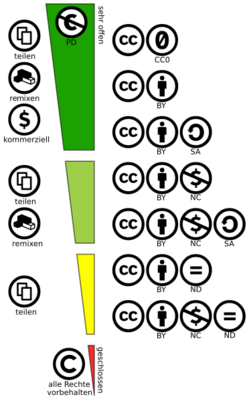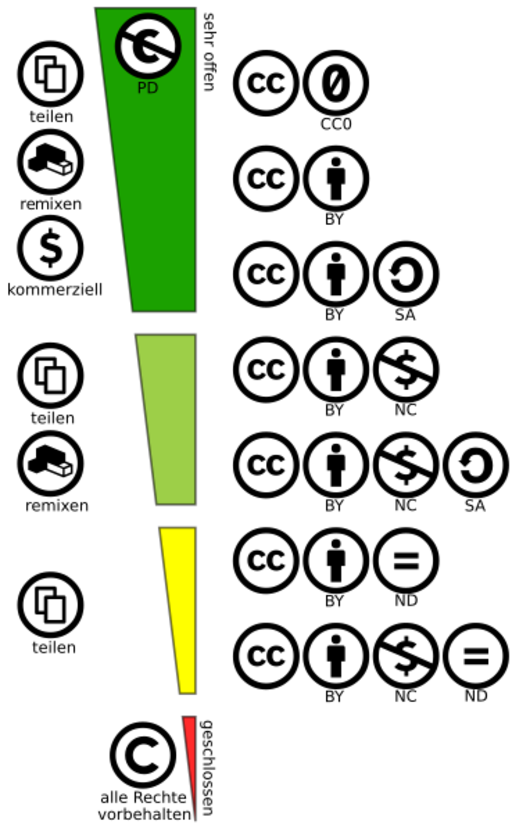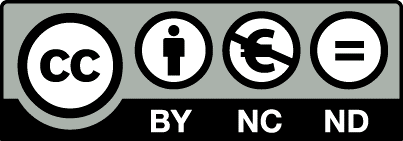Anbr (Diskussion | Beiträge) (Nutzung ergänzt) |
|||
| Zeile 74: | Zeile 74: | ||
==== Further information about Creative Commons licenses==== | ==== Further information about Creative Commons licenses==== | ||
[https://de.creativecommons.org de.creativecommons.org] | [https://de.creativecommons.org de.creativecommons.org] | ||
| + | ===Use of materials=== | ||
| + | The use of materials is also subject to copyright, i.e. any use of texts, graphics, images, audio and video recordings, ... requires a copyright permission. Materials are only released for personal use in the context of study and teaching. Copying, passing on, publishing on websites, commercial use, ... are generally prohibited. Further use is only permitted if the originator (e.g. the lecturer) allows further use, e.g. if materials are explicitly marked as "Public Domain", are subject to a license model, e.g. the Creative Commons Initiative, the author agrees to the use in another way, or if the use is explicitly permitted by copyright law: This applies, for example, to the above-mentioned exceptions for "teaching and learning" (§60 (1) UrhG) or "reproductions for private use" (§53 (1) UrhG). | ||
| + | |||
===Additional copyright information=== | ===Additional copyright information=== | ||
| − | [https://irights.info/wp-content/uploads/2017/11/Leitfaden_Rechtsfragen_Digitalisierung_in_der_Lehre_2017-UrhWissG.pdf | + | [https://irights.info/wp-content/uploads/2017/11/Leitfaden_Rechtsfragen_Digitalisierung_in_der_Lehre_2017-UrhWissG.pdf Kreutzer, T., Hirche, T.: Leitfaden Rechtsfragen Digitalisierung in der Lehre] |
| + | |||
| + | [https://www.uni-bremen.de/urheberrecht Universität Bremen: Urheberrecht für die Hochschule] | ||
=== Recording of video conferences=== | === Recording of video conferences=== | ||
Version vom 1. März 2021, 16:04 Uhr
Use of digital materials / copyright[Bearbeiten | Quelltext bearbeiten]
For teaching in Corona times, there are no differences in copyright law to the generally applicable guidelines. However, more digital media are currently being created, distributed and used, for which some basic rules must be observed:
Foreign materials[Bearbeiten | Quelltext bearbeiten]
If you integrate foreign materials into your teaching offer, you need a copyright permission. This can be granted by the author, purchased from publishers or assigned via licenses. There are also restrictions on teaching (§ 60a UrhG "Unterricht und Lehre"), whereby parts of works may be made available to a limited number of participants in courses. Please note in particular the respective permissible scope, e.g. a maximum of 15% of books may be used.
- The following graphic gives an overview:
- Further information from the University Library on the provision of foreign materials in learning platforms:
- An explanatory video on the website of ELAN e.V. explains how copyright-protected materials may be made available in teaching in conformity with the law:
A general permission for use in teaching exists for OER materials (Open Educational Resources). These free educational materials are provided under a license that allows free use in university teaching. You too can check whether you can publish your materials in a way that allows free use in teaching. This creates an increasingly large pool of OER materials.
A video on the following page provides an introduction to the topic of OER:
https://open-educational-resources.de/dossierseite/?praxis=allgemein&bereich=hochschule
Provision of own materials[Bearbeiten | Quelltext bearbeiten]
The materials created by the students themselves and made available to them in the course of their studies are also subject to copyright. Students may use these materials within the framework of their studies and, if applicable, for other purposes specified by you. The passing on to third parties without your permission is not permitted by law.
If you want to define such further purposes, the license model of the Creative Commons Initiative, which has set a worldwide standard as follows, is suitable for this purpose.
This allows you to define further use for your materials with some predefined rights:
| by | Use by other persons is permitted but requires the name of the author to be mentioned. | |
| nc | Use is only permitted for non-commercial purposes. (Non-Commercial) | |
| nd | The materials may only be used unchanged and without further processing (No Derivatives) | |
| sa | The materials may be changed but must be passed on under the same conditions (Share Alike) | |
| cc0 | Die Materialien dürfen ohne weitere Bedingungen frei genutzt werden (Public Domain) |
The individual permissions can be combined as follows, from a free right of use (very open) to a limited right of use that requires individual permission (all rights reserved / closed):
 |
Source reference for the left graph:
Wikipedia: Creative Commons license spectrum. https://de.wikipedia.org/wiki/Datei:Creative_Commons_Lizenzspektrum_DE.svg creativecommons.org/licenses/by/4.0 |
In case of use (except CC0) the following references are required: Author: Title. Source, any modifications, license, license link (see example in the upper right graphic)
Examples for the use of CC Licenses[Bearbeiten | Quelltext bearbeiten]
| A scientific text that you publish under the CC BY license (attribution) may be used by anyone, but must include your name. | |
| You could publish the description of a didactic scenario, which is not to be changed and taken out of context and is not to be used by companies, under the license CC BY NC ND (attribution, non-commercial, no changes). Note that copyright only protects the concrete text, not the idea described in it. Your text of a didactic scenario under the CC BY NC ND license may not be printed or posted on the Internet, but it may be used for such a scenario. |
Further information about Creative Commons licenses[Bearbeiten | Quelltext bearbeiten]
Use of materials[Bearbeiten | Quelltext bearbeiten]
The use of materials is also subject to copyright, i.e. any use of texts, graphics, images, audio and video recordings, ... requires a copyright permission. Materials are only released for personal use in the context of study and teaching. Copying, passing on, publishing on websites, commercial use, ... are generally prohibited. Further use is only permitted if the originator (e.g. the lecturer) allows further use, e.g. if materials are explicitly marked as "Public Domain", are subject to a license model, e.g. the Creative Commons Initiative, the author agrees to the use in another way, or if the use is explicitly permitted by copyright law: This applies, for example, to the above-mentioned exceptions for "teaching and learning" (§60 (1) UrhG) or "reproductions for private use" (§53 (1) UrhG).
Additional copyright information[Bearbeiten | Quelltext bearbeiten]
Kreutzer, T., Hirche, T.: Leitfaden Rechtsfragen Digitalisierung in der Lehre
Universität Bremen: Urheberrecht für die Hochschule
Recording of video conferences[Bearbeiten | Quelltext bearbeiten]
The depiction of persons interferes with their personal rights ("right to one's own image"). Video recordings, i.e. also recordings of video conferences, therefore require the explicit consent / approval of all recorded participants. You should therefore only make recordings for your own lectures (if the video cameras of all participants are deactivated) or for small seminars if this is necessary and you have the consent of all participants.
Policy / Usage hints for temporarily set up services[Bearbeiten | Quelltext bearbeiten]
The University of Paderborn has set up some new services and procured temporary licenses for external services in order to cope with the Corona crisis. Please note the following:
- Most additional services are offered on a trial basis. They do not offer guaranteed stability and availability and only limited support possibilities. Find out about the services you are using and also check whether they have a data backup, for example, or whether you should store your data additionally.
- Look into the respective usage and data protection notes, especially for which data the respective service may be used.
- External services for which the university has not concluded contractual agreements may only be used to a limited extent. Please refer to the data protection information on cloud services of American providers.
Privacy[Bearbeiten | Quelltext bearbeiten]
The central services of the university are each provided with a privacy policy. Please note that this only applies to the purposes described there and that as soon as you download personal data from the systems you must ensure that you yourself comply with data protection regulations. Personal data may only be processed for the required purposes and must be protected against unauthorized access. Therefore, external services always require separate agreements and measures to ensure compliance with data protection and IT security and should only be used where recommended by the University or after consultation with the data protection coordinator or data protection officer and to ensure that they are used in accordance with data protection regulations.
- You can find information on data protection and necessary measures under:
Disclaimer[Bearbeiten | Quelltext bearbeiten]
This information does not claim to be complete. In order to safeguard oneself in specific cases, legal advice may be required which IMT cannot and must not provide. The IMT does not guarantee that the information provided is up-to-date, correct and complete.

